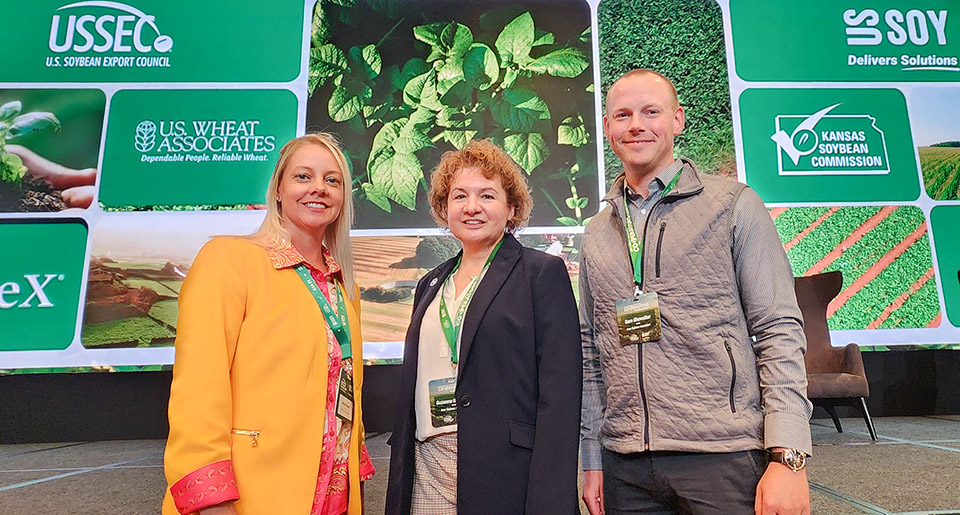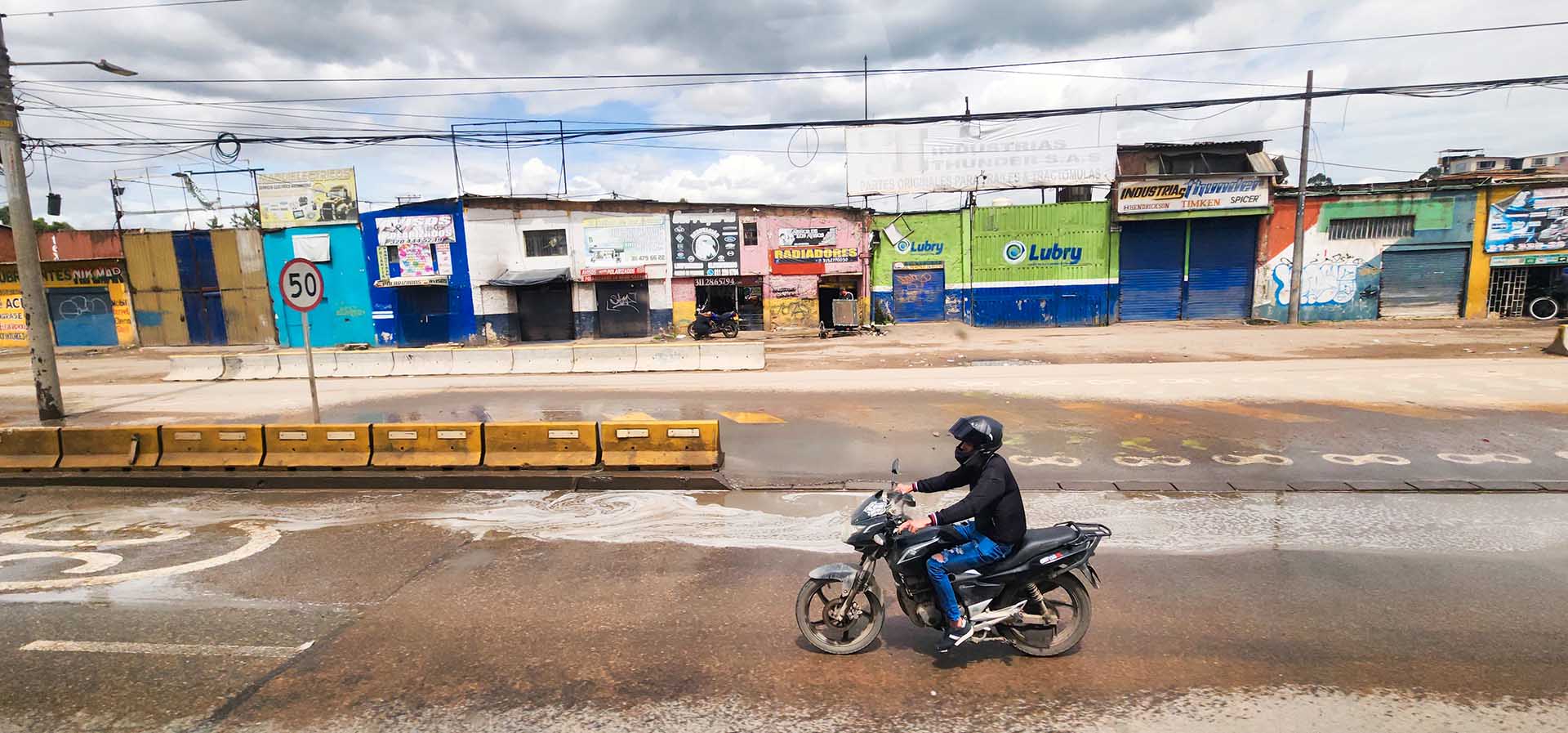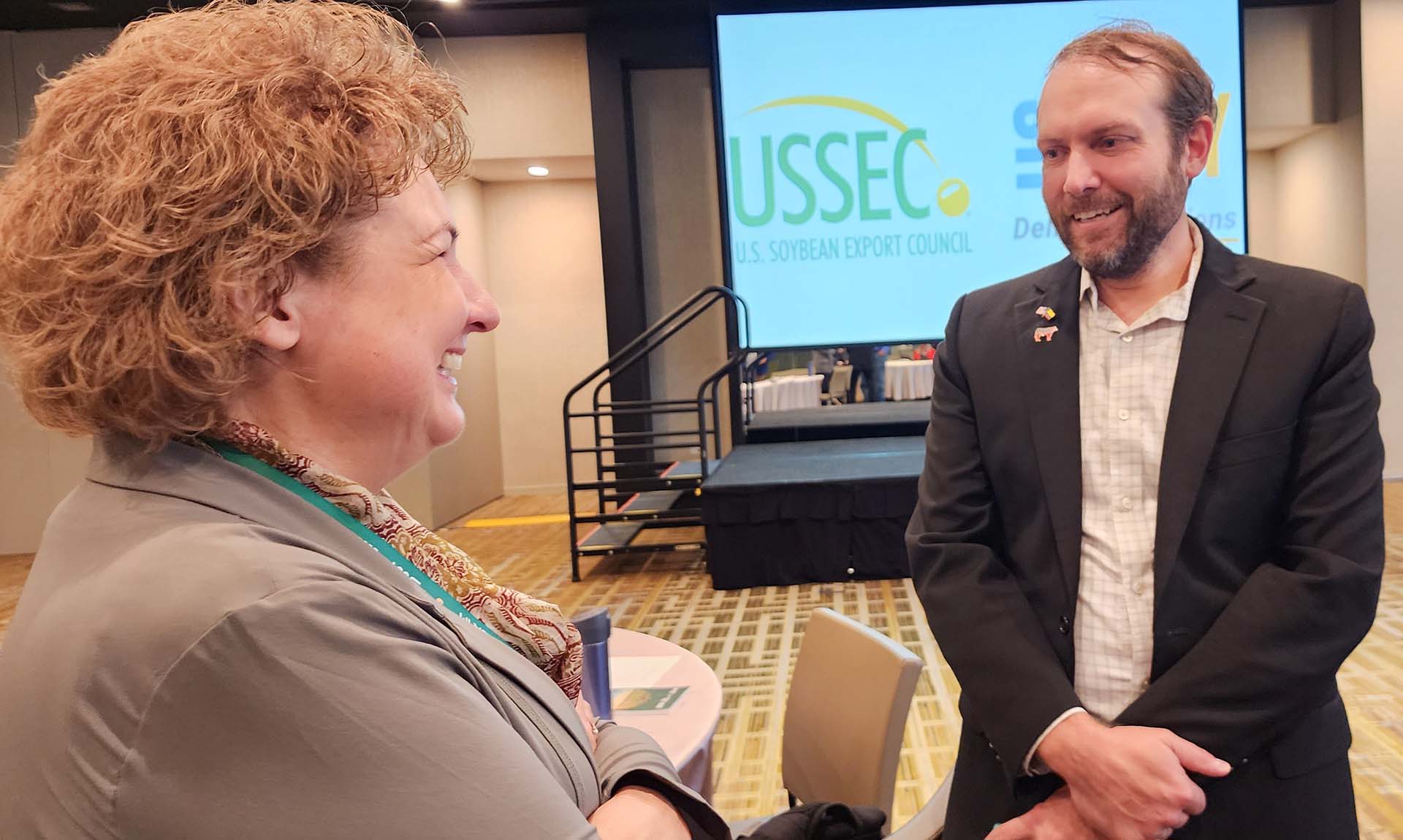
(Photo: Iowa Soybean Association / Aaron Putze)
Iowa soybean farmers in Colombia engage buyers and boost U.S. soybean sales
June 13, 2024 | Aaron Putze, APR
Three Iowa Soybean Association (ISA) farmer directors are in Colombia this week seeking to boost already strong soybean sales to the country of more than 50 million.
President Suzanne Shirbroun of Farmersburg, Aimee Bissell of Bedford (At-Large director) and Sam Showalter of Hampton (District 2 director) are among nearly 250 guests attending U.S. Soybean Export Council’s (USSEC) Americas Agricultural Cooperators Conference in Bogota.
The two-day event, sponsored in part by ISA, gathers soybean buyers, feeders and processors from throughout Central and South America. They engage with American soybean farmers about crop progress and yield prospects, exchange ideas and industry best practices and are briefed about the value, reliability and performance of U.S. soybeans.
While in Colombia, Shirbroun and Bissell also joined in a tour of Solla Feed (a buyer of U.S. soy) located on the outskirts of Bogota and received regional ag, food and market briefings by USSEC staff and U.S. and Colombia ag officials.

Valued customer
Located on the northwest tip of South America, Colombia is a valued customer for Iowa and U.S. farmers. It’s the sixth largest market for U.S. agriculture and the world’s third largest importer of U.S. soybean meal.
In 2022-23, Colombia purchased 1.88 million metric tons (mmt) of U.S. soy. This included 443,000 mt of whole soybeans and 1.43 mmt of soybean meal.
U.S. soybean farmers enjoy 78% market share for Colombia’s entire soy complex. This includes 90% of the whole soybean market and 86% of the soybean meal imports.
“Soy and corn are the stars of raw ingredients for feed produced in Colombia,” says Laura Pasculli of the Colombia Feed Association. “Our main vendor is the U.S., with some sourced from Brazil when tariffs are low.”
A U.S.-Colombia Trade Promotion Agreement implemented in 2012 has fueled greater cooperation between both countries. The pact eliminated 80% of all tariff lines with a total phase out by 2030. U.S. ag exports have surged 232% since its signing. It’s also been beneficial for Colombia, with the U.S. accounting for 27% of total Colombian exports including ag products such as coffee, cut flowers and fruit.
Most encouraging for the U.S. soybean industry is the potential to increase sales to an already strong customer. A rising middle class in Colombia means greater per-capita consumption of poultry, eggs, pork and fish - all soy consumers.
Boosting U.S. exports of soybean meal to such a friendly and reliable trading region is especially noteworthy as expansion of America’s biofuels production continues.
“Animal and aqua feeders know the difference between U.S. and Brazilian soybean meal and they know what they like and prefer,” says Shirbroun, who participated in a panel discussion on the conference’s opening day. “Buyers want it to keep their millers and meat and aqua farmers happy.
“We need to continue to provide them with a quality, reliable and uniform product. And that’s why we’re here.”
All soy is not created equal. Variabilities include the bean’s genotype as well as planting area, soil type, agricultural practices, environmental conditions during the growing season and storage method. These variables affect the chemistry, composition, protein and overall quality and nutritional value of whole soybeans and soybean meal.
USSEC’s mission is to create a preference for U.S. soy by nurturing relationships, growing awareness and demonstrating value. Essential to the mission is differentiating the quality and value of U.S. soy from other nutrition and energy products, elevating collaboration and partnerships across the U.S. supply chain and attaining access to markets through dialogue and cooperations.
Conference attendees, including those representing the production of animal and aqua species in Mexico, Venezuela, Ecuador and Mexico, say U.S. soy distinguishes itself on its composition, consistency and sustainability. The result is greater feed efficiency and animal performance.

Poised for growth
Mark Rosmann serves as the Agricultural Attaché for USDA’s Foreign Agricultural Service based in the U.S. Embassy in Bogota. The Harlan, Iowa, native says Colombia’s economy is poised for growth as inflation recedes and more people rise to middle class (those with an annual income of $3,000+ U.S).
Consumer-oriented U.S. exports to Colombia include pork and pork products, dairy and poultry products. Products classified as “intermediate” include soybean meal (valued at $762 million (M) in 2023), ethanol ($224 M), bulk soybeans ($236 M value), corn ($1.1 billion ) and wheat ($135 M).
Ag exports from Colombia to the U.S. include coffee, cut flowers, bananas, raw sugar, pulses, and processed sugars.
In 2023, Colombia was the third largest market for U.S. soybean meal exports, sixth largest for U.S. soybean oil exports and 14th largest for U.S. soybean exports.
Opportunities exist in Colombia for additional purchases of U.S. ag commodities, says Rosmann, especially those that include a sustainability certification.
“We’re seeing increased urbanization, growth of e-commerce, increasing demand for healthier, sustainably-produced products and recovery of the middle class,” he says. “U.S. soy certainly has a role to play, especially soy for human health.”
Despite the optimism, challenges remain. Market constraints include sticky-high inflation, peso fluctuations, emerging nutritional regulations and requirements, and consumer price sensitivity.
Colombians devote 31% of their income for food and another 24% to housing. Nearly one-fourth of the population eats less than three meals daily due to economic hardships.
Rosmann says business relationships take time to cultivate in Colombia and the region but flourish once they are established.
Which is exactly why the USSEC’s cooperators conference focused on the Americas region is so valuable.

Trade vital
“I speak for many when I say how much we look forward to this impactful event each year,” says USSEC CEO Jim Sutter. “The trade we do is vital for both partners.”
Sutter says the Americas region is second only to China in soy imports, purchasing 15 mmt of soybeans, meal and oil. This accounts for 25% of U.S. soy exports worldwide.
Robust trade, says Sutter, is critical to meeting the needs and demands of countries and consumers.
“Some are calling for less rather than more trade,” he says. “This is really hard for me to imagine because I’ve seen how trade has benefited so many countries around the world.”
It’s important, he added, that those gathered for the cooperators conference use their collective voices to advocate the importance of trade.
“I try to do this every chance I get, especially those with a slightly different view. Every country has its own competitive advantages in producing food that they can use to their advantage for their people.
“U.S. soybean farmers and Americas share great trust and are bilateral partners, with ag as one of our biggest success stories,” Sutter says. “We look forward to continued growth and evolution of our trusted relationships as we build a future that’s prosperous and sustainable.”
Back